Want to make homemade pizzas with crispy crusts and have them ready in no time? Try the Ooni pizza steel.
Our editors and experts handpick every product we feature. We may earn a commission from your purchases.
Learn more.
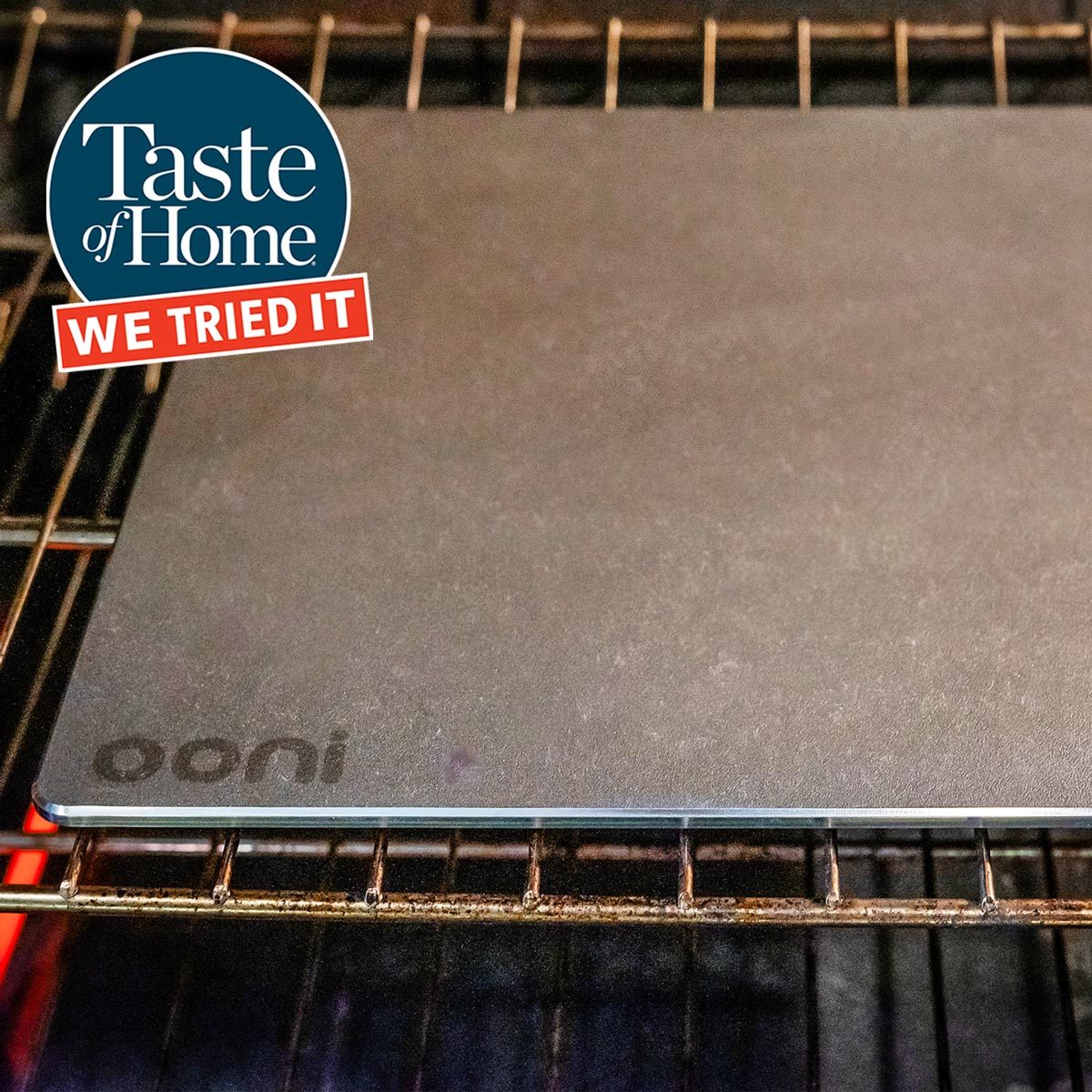

Want to make homemade pizzas with crispy crusts and have them ready in no time? Try the Ooni pizza steel.
Our editors and experts handpick every product we feature. We may earn a commission from your purchases.
Learn more.
Pizza nights at home in a conventional oven make for a relatively easy dinner. The problem? Typically, baking on a simple cookie sheet produces a crust that’s just so-so. Sometimes, it might even be a bit soggy thanks to all of those delicious toppings weighing it down. Not to mention, it takes 20 to 30 minutes to cook.
While Ooni is known for its outdoor pizza oven options, the brand also has a clever kitchen item for pizza lovers who want a crispy crust—the Ooni pizza steel. I’ve tested multiple pizza ovens, but at a much lower price point than the investment of a pizza oven, we decided to put the Ooni pizza steel to the test to see just how it stacked up.
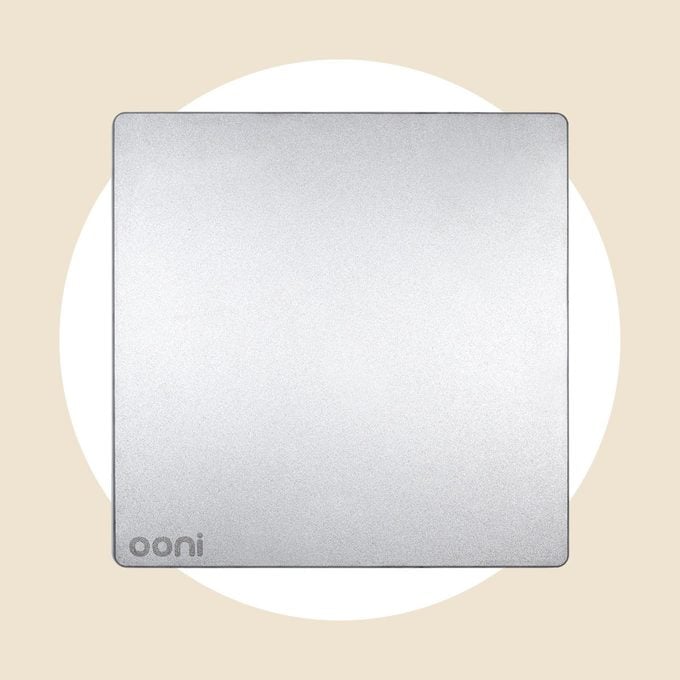 VIA MERCHANT
VIA MERCHANT
The Ooni Pizza Steel 13 lets you make pizzas at home without a traditional pizza oven. The stainless steel is an ideal cooking surface for evenly cooked crusts on all pizza varieties and styles.
The Ooni pizza steel is a great alternative to a pizza stone and can be used in your conventional kitchen oven. Its shape and size are similar to a regular baking sheet, but it conducts and retains heat more efficiently, thanks to its sand-blasted stainless steel. It’s perfect for home pizza cooks who love a great, evenly-cooked crust.
The pizza steel is a light gray color with an exterior texture of sandpaper. At 11.5 pounds, it has a great weight to it, making it incredibly durable. It is easy to use and can be quickly placed on the middle rack of your kitchen oven. Because it’s constructed of stainless steel, it harnesses the heat from a conventional oven and retains it well, allowing you to evenly cook a pizza with a crispy crust.
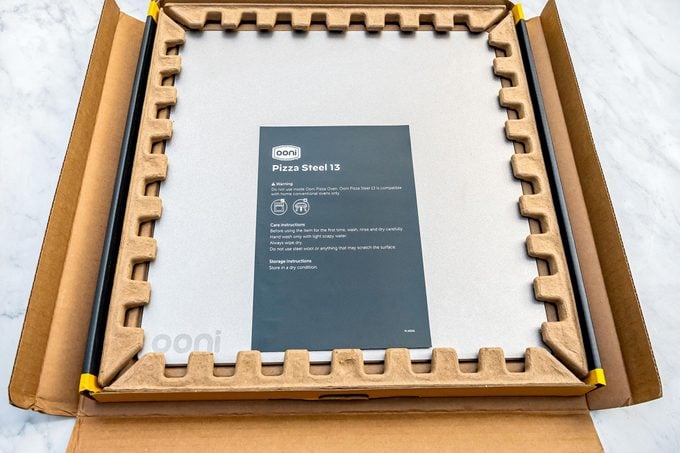
To get started on using the Ooni pizza steel, all I had to do was remove it from the box. The steel is an all-in-one accessory, so no assembly is needed. The packaging advised giving the steel a quick wash with light soap and water before cooking with it.
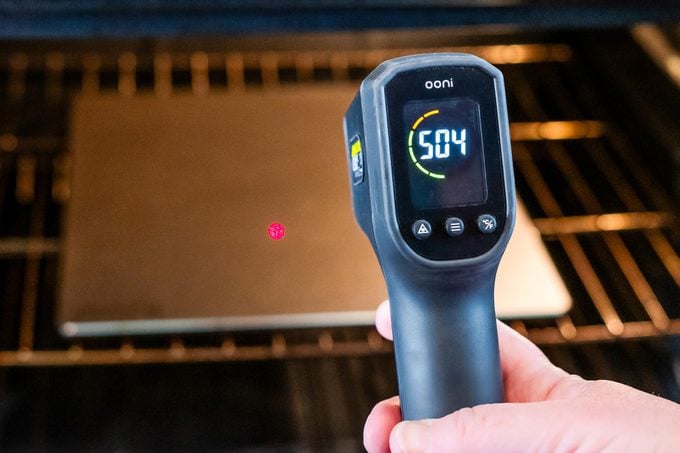
The Ooni pizza steel requires heat from your oven to create a hot surface. Once heated, it mimics a pizza stone in a true pizza oven. Before putting any pizzas in the oven, the first step is to turn the oven on to its highest temperature and allow it to preheat. I let my oven preheat to 500 degrees, placed the pizza steel on the center rack, and waited for it to preheat for 30 minutes before cooking. After 30 minutes, I used an infrared thermometer which told me the temperature of the steel was at a surprising 504 degrees.
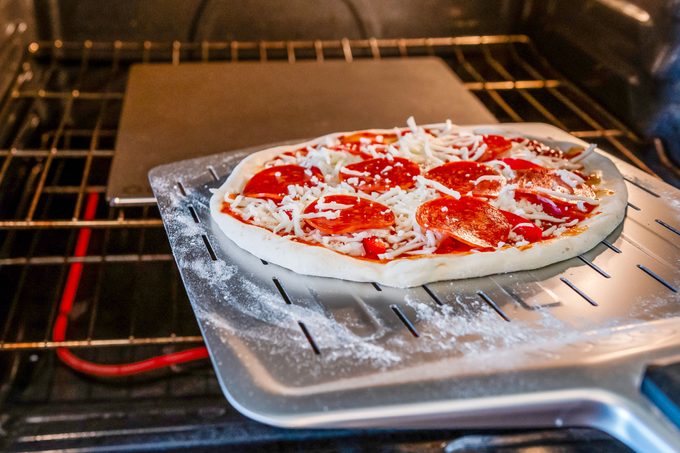
Cooking with the Ooni pizza steel is very similar to using an outdoor pizza oven. That’s to say that you should not be removing the pizza steel between pies. While it can retain heat fairly well, it requires reheating between pizzas if you remove it from the oven, which could increase your cooking time exponentially depending on how many pies you plan to make. As such, the steel must be left in the oven to properly heat up, making access to a pizza peel to build your pizza and transfer it into the oven essential.
I tested the pizza steel by making numerous pizzas, sliding each onto the steel with a perforated pizza peel. I found that each pizza took between 8 and 10 minutes to cook, depending on the toppings used. You could tell the pizza steel helped to set and cook the crust quickly while creating a crispy base. The heat radiated in the oven, and the toppings were cooked and the cheese melted.
Once each pizza was cooked, I used the pizza peel to retrieve it from the oven and allowed it to set and rest for a few minutes before grabbing a pizza cutter and digging in!
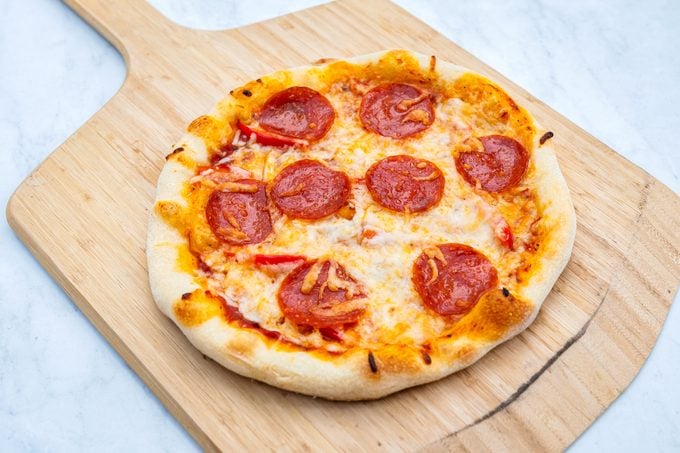
After finishing a pizza session, Ooni advises leaving the pizza steel in the oven to cool for two hours, reducing the risk of injury or fire. Following this guideline, I turned off the oven and let the steel cool. While this wait time wasn’t an issue for me, it could be inconvenient if you need the oven for other cooking tasks.
Once cooled, I cleaned the pizza steel with light soap and water. A slight grease stain remained, but it didn’t affect the flavor or performance when used again.
In my testing, the pizza stone preheated to over 500 degrees in about 30 minutes. However, some users report it can take up to an hour, which may depend more on the oven than the stone itself.
Ooni recommends cooling the pizza stone in the oven for at least two hours before handling. I strongly advise following this guidance to avoid the risks of burns or damage. Attempting to cool the stone with water could cause a dangerous steam flare-up, warp, or even crack the steel. Even with proper cooling, heat-resistant oven gloves are advisable until fully cooled.
Although primarily intended for pizza, Ooni’s pizza steel is highly versatile and suitable for baking bread or searing meats, thanks to its heat tolerance. While Ooni doesn’t specifically promote alternative uses or provide recipes, experimenting with the steel can greatly expand its utility, making it a valuable multipurpose tool.
Don’t just take it from us on the benefits of the pizza steel. Verified Ooni buyer Bethany says she loves this option as an alternative. “It cooks our pizza perfectly every time in the oven! This is a great alternative in the super cold winter months when we don’t want to go outside and use the wood-burning Ooni. Definitely recommend!”
Verified buyer Janet noted that this was a great swap from her pizza stone. “Previously used a pizza stone in my indoor oven, but this retains the heat even better for a nice crispy crust. In the winter, this is now my go-to way to make pizza,” she says.
Another reviewer, John, noted he uses it for pizzas and more. “My Ooni pizza steel is awesome—my pizza crusts are MUCH more authentic. I also use my pizza steel for cooking other dishes; overall, the extra heat makes cooking all my dishes easier.”
Made and sold by Ooni, the pizza steel is a significantly different product than an outdoor pizza oven like the Ooni Koda 16 or Ooni Volt. Pizza ovens are all electric or utilize gas, wood or charcoal fuel to heat up a cordierite pizza stone and radiate heat within the pizza oven, reaching temperatures of 950 degrees. The Ooni pizza steel, on the other hand, is for use in conventional ovens up to 527 degrees.
While the pizza steel helps create an even bake with a crispy crust, it does not mimic the same texture and flavor of a pizza baked in an outdoor pizza oven, like a Solo Stove. However, the pizza steel is significantly more affordable than purchasing a pizza oven (even if you happen to find a great pizza oven sale).
If you have an Ooni Koda, you may be wondering if you should use a steel or a stone in it. Pizza steels are for use only in conventional home ovens, while pizza stones can be used in conventional home ovens and in dedicated pizza ovens. The difference is in heat retention, transfer and release. Steel gets too hot, too quickly for use in a pizza oven, while stone heats up more slowly and transfers less heat, leading to better crusts when used in a pizza oven.
The opposite is true when used in a conventional home oven. In the latter case, steel is superior because of its heat transfer qualities. In a home oven, using a pizza steel results in crispier crusts without burning your toppings. A stone, on the other hand, can lead to softer (and sometimes soggy) crusts; it will also take longer to cook your pie compared to a steel.
The Ooni pizza steel is a relatively affordable pizza-making tool for leveling up your pizza nights. Say goodbye to soggy crusts! The main key to note is that the flavor will not be the same as it is in an outdoor pizza oven, simply because conventional home ovens cannot reach high enough temperatures to create the reaction needed with the dough.
Because of its heat retention, it eliminates a lot of the baking time a regular baking sheet requires for pizza. Cooking a pizza in a regular home oven in under 10 minutes is pretty impressive. For those who do have a pizza oven, it’s still a great choice for when a craving strikes while it’s raining or snowing outside. If you’re a fan of pizzas with great texture and a crisp crust, this is a worthy addition to your regular pizza nights.
 VIA MERCHANT
VIA MERCHANT
The Ooni Pizza Steel 13 lets you make pizzas at home without a traditional pizza oven. The stainless steel is an ideal cooking surface for evenly cooked crusts on all pizza varieties and styles.
The Ooni Pizza Steel 13 retails for $100 and is available on Ooni’s website, Williams Sonoma, Ace Hardware and Amazon. Snag one now to start making delicious pies for a little dough.
If you’re choosing between using a pizza steel or a pizza stone in your conventional home oven, it all comes down to heat retention. Because of its material, a pizza steel conducts and retains heat more efficiently than a stone does. The other benefit of a pizza steel is that it’s incredibly durable and not as easy to crack or break.
A pizza steel’s higher heat, superior conductivity and heat retention can be too intense for some cooking styles, potentially causing burnt bottoms if not carefully managed. If you’re used to pizza stones, expect a learning curve with the steel. We strongly recommend monitoring your pizza closely until you understand how the steel impacts cook time.
If you don’t plan to make your own pizza dough and gather all the toppings, the pizza steel can still be used for cooking pizza. You can grab a thawed, store-bought pizza and cook it on the pizza steel, or even use it for cooking frozen pizzas.
No—if you have an Ooni pizza oven, you don’t need a pizza steel. It should only be used in a conventional home oven. Pizza ovens use stone slabs because the ovens get so much hotter than standard home ovens. Using a pizza steel in a pizza oven will result in temperatures that are too high, and you’ll wind up with a very burnt pizza crust.
Per the Ooni Help Center, the brand advises to “never using a pizza steel in place of a baking stone in an Ooni oven. Ooni ovens are optimized for use with the included cordierite baking stone and the higher thermal conductivity of steel is more likely to result in burnt pizza bases and could be unsafe to use.”
We hate to sound like a broken record, but as is almost always the case, the answer to this is: It depends. If you don’t have the budget for a pizza oven, a pizza steel is a much more affordable way to achieve perfectly crisp, but not overdone, pizza crusts in your regular oven. They’re also a great choice for people who live in apartments, condos or homes without the outdoor space for a good pizza oven. Even if you do have the budget and ample outdoor space, a pizza steel allows you to make great pizzas when the weather’s not in your favor. But if you want maximum control over your pies and treat pizza-making like an art, an outdoor pizza oven is the way to go.
A former bakery owner and event planner, Molly Allen is a shopping writer and product tester specializing in food and beverage, lifestyle, holidays and parties. She brings her years of experience and industry knowledge to Taste Recipes readers, drawing on her former life at a bakery to inform her content, especially regarding kitchen appliances and other gear. Her expertise makes her the perfect candidate to test and speak on Ooni’s pizza steel.
Sean Tirman, content updates editor at Taste Recipes, updated and contributed research to this piece. Sean has written shopping guides since 2016 and is a former associate editor at Gear Patrol. Amanda Capritto, also a content updates editor at Taste Recipes, updated and contributed research to this piece. Amanda is a consumer journalist and former commerce editor at Garage Gym Reviews.